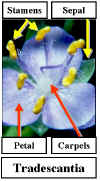| Flowers Overview
|
The Flower represents the most important reproductive
adaptation for plants . The Ovules of the flower are
enclosed by the Ovary Wall or Pericarp.
This protects them during their development and maturation. Furthermore, the Pericarp becomes the principal part of the Fruit.
. The Ovules of the flower are
enclosed by the Ovary Wall or Pericarp.
This protects them during their development and maturation. Furthermore, the Pericarp becomes the principal part of the Fruit.
Fruits not only add another protective layer but they also have specific adaptations for seed dispersal by biotic and abiotic agents.
Vegetative and Floral Organs
Plants contain various organs. These can be divided into vegetative and reproductive. The Vegetative Organs are the Root, Stem and Leaf.
Floral organs are modified leaves! They are formed at the shoot apex in the same manner as other leaves, and some floral parts, like sepals and petals, may be clearly leaf-like in their morphology.
While most Stamens and Carpels are not "leafy" in their appearance, some plants, like Paeony, produce leaf-like Stamens and Carpels. Finally, careful anatomical studies have shown that all floral organs are modified leaves.


The Sepals constitute the Calyx
The Petals comprise the Corolla
The Sepals and Petals are collectively called the Perianth.
When the Sepals & Petals are identical, they are both called Tepals

Stamens comprise the Androecium (Male House)

Carpels comprise the Gynoecium (Female House).
The morphological unit of the Gynoecium is the Carpel.
The term Pistil has been used in the past to describe the gynoecium and this can cause some confusion in terminology.
A Gynoecium of a flower may contain 1 carpel, 2 carpels or n Carpels.
The Carpels may be free (Apocarpous) or united (Syncarpous)
